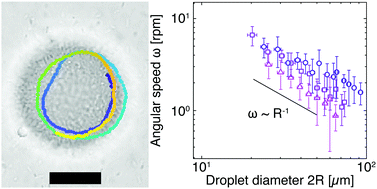Rotating oil droplets driven by motile bacteria at interfaces†
Abstract
We show that oil droplets suspended near a liquid–solid interface can be driven to rotate by motile bacteria adhered to the droplet surface. Droplets rotate clockwise when viewed from the liquid side, due to symmetry-breaking hydrodynamic interactions of bacteria with the interface. The angular speed of rotation for droplets decreases as their size is increased. Differences in the speed of rotation driven by Escherichia coli, Shewanella haliotis, and Halomonas titanicae bacteria reflects differences in the number of bacteria adhered at the droplet surface and their interfacial affinity. Adding surfactant reduces the number of adherent bacteria and hence lowers the speed of rotation. Together, these results demonstrate that bacterial activity can be used to manipulate suspended droplets.



 Please wait while we load your content...
Please wait while we load your content...